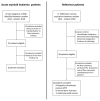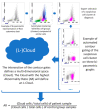Clustering and Kernel Density Estimation for Assessment of Measurable Residual Disease by Flow Cytometry
- PMID: 32443428
- PMCID: PMC7277972
- DOI: 10.3390/diagnostics10050317
Clustering and Kernel Density Estimation for Assessment of Measurable Residual Disease by Flow Cytometry
Abstract
Standardization, data mining techniques, and comparison to normality are changing the landscape of multiparameter flow cytometry in clinical hematology. On the basis of these principles, a strategy was developed for measurable residual disease (MRD) assessment. Herein, suspicious cell clusters are first identified at diagnosis using a clustering algorithm. Subsequently, automated multidimensional spaces, named "Clouds", are created around these clusters on the basis of density calculations. This step identifies the immunophenotypic pattern of the suspicious cell clusters. Thereafter, using reference samples, the "Abnormality Ratio" (AR) of each Cloud is calculated, and major malignant Clouds are retained, known as "Leukemic Clouds" (L-Clouds). In follow-up samples, MRD is identified when more cells fall into a patient's L-Cloud compared to reference samples (AR concept). This workflow was applied on simulated data and real-life leukemia flow cytometry data. On simulated data, strong patient-dependent positive correlation (R2 = 1) was observed between the AR and spiked-in leukemia cells. On real patient data, AR kinetics was in line with the clinical evolution for five out of six patients. In conclusion, we present a convenient flow cytometry data analysis approach for the follow-up of hematological malignancies. Further evaluation and validation on more patient samples and different flow cytometry panels is required before implementation in clinical practice.
Keywords: acute myeloid leukemia (AML); clustering; flow cytometry; kernel density estimation; multiparametric data analysis; personalized medicine.
Conflict of interest statement
The authors declare no conflict of interest.
Figures




Similar articles
-
A 19-color single-tube full spectrum flow cytometry assay for the detection of measurable residual disease in acute myeloid leukemia.Cytometry A. 2024 Mar;105(3):181-195. doi: 10.1002/cyto.a.24811. Epub 2023 Dec 8. Cytometry A. 2024. PMID: 37984809
-
MRD Monitoring by Multiparametric Flow Cytometry in AML: Is It Time to Incorporate Immune Parameters?Cancers (Basel). 2022 Sep 1;14(17):4294. doi: 10.3390/cancers14174294. Cancers (Basel). 2022. PMID: 36077826 Free PMC article. Review.
-
Immunophenotypic Detection of Measurable Residual (Stem Cell) Disease Using LAIP Approach in Acute Myeloid Leukemia.Curr Protoc Cytom. 2019 Dec;91(1):e66. doi: 10.1002/cpcy.66. Curr Protoc Cytom. 2019. PMID: 31763792 Free PMC article.
-
[Detection of Minimal Residual Disease in Acute Myeloid Leukemia by Multi-color Flow Cytometry].Zhongguo Shi Yan Xue Ye Xue Za Zhi. 2022 Apr;30(2):341-345. doi: 10.19746/j.cnki.issn.1009-2137.2022.02.003. Zhongguo Shi Yan Xue Ye Xue Za Zhi. 2022. PMID: 35395960 Chinese.
-
Measurable Residual Disease in Acute Myeloid Leukemia Using Flow Cytometry: A Review of Where We Are and Where We Are Going.J Clin Med. 2020 Jun 3;9(6):1714. doi: 10.3390/jcm9061714. J Clin Med. 2020. PMID: 32503122 Free PMC article. Review.
Cited by
-
Applications of machine learning for immunophenotypic measurable residual disease assessment in acute myeloid leukemia.Hemasphere. 2025 May 21;9(5):e70138. doi: 10.1002/hem3.70138. eCollection 2025 May. Hemasphere. 2025. PMID: 40400510 Free PMC article. Review.
-
Computational assessment of measurable residual disease in acute myeloid leukemia using mixture models.Commun Med (Lond). 2024 Dec 19;4(1):271. doi: 10.1038/s43856-024-00700-x. Commun Med (Lond). 2024. PMID: 39702555 Free PMC article.
References
-
- Da Costa E.S., Pedreira C.E., Barrena S., Lécrevisse Q., Flores-Montero J., Quijano S., Almeida J., Macias M.D.C.G., Böttcher S., Van Dongen J.J., et al. Automated pattern-guided principal component analysis vs expert-based immunophenotypic classification of B-cell chronic lymphoproliferative disorders: A step forward in the standardization of clinical immunophenotyping. Leukemia. 2010;24:1927–1933. doi: 10.1038/leu.2010.160. - DOI - PMC - PubMed
-
- Kalina T., Flores-Montero J., Van Der Velden V.H.J., Martín-Ayuso M., Böttcher S., Ritgen M., Almeida J., Lhermitte L., Asnafi V., Mendonça A., et al. EuroFlow standardization of flow cytometer instrument settings and immunophenotyping protocols. Leukemia. 2012;26:1986–2010. doi: 10.1038/leu.2012.122. - DOI - PMC - PubMed
-
- Lacombe F., Dupont B., Lechevalier N., Vial J.-P., Pigneux A., Bene M.C. New Concepts of Flow Cytometry Analysis in Oncohematology: Application to Diagnosis and Follow up (Minimal Residual Disease) in AML, ALL and MDS. Blood. 2017;130(Suppl. 1)
LinkOut - more resources
Full Text Sources
Research Materials

